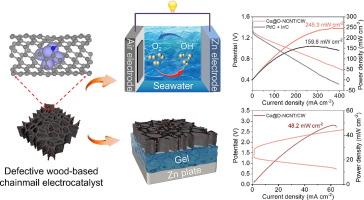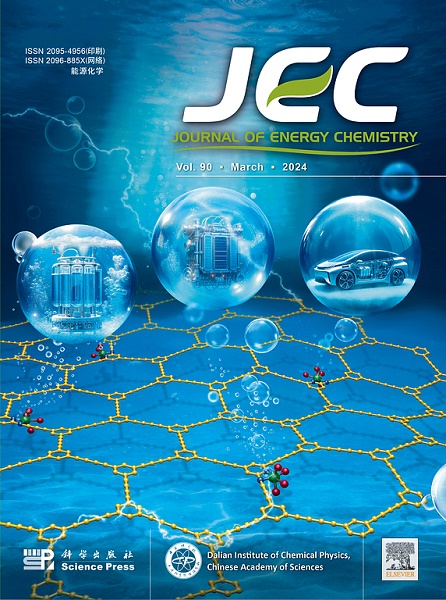缺陷木质链状电催化剂提高了海水-中型锌-空气电池的性能
IF 13.1
1区 化学
Q1 Energy
引用次数: 0
摘要
高活性、稳定的氧还原反应(ORR)和氧进化反应(OER)双功能电催化剂对于基于海水的锌空气电池(ZAB)至关重要。在此,我们报告了一种由木材衍生的链状电催化剂,该催化剂含有封装钴纳米颗粒的缺陷氮掺杂碳纳米管(Co@D-NCNT/CW),可提高海水介质中 ORR/OER 的活性和稳定性。在制备过程中,锌的引入和去除增加了碳材料中的缺陷位点和吡啶N含量,调节了电荷分布并影响了吸附和活化过程。Co@D-NCNT/CW 中高度有序的开放通道促进了反应物的传质并加速了气体扩散。由此产生的链锁电催化剂在海水碱性电解质中表现出令人印象深刻的 ORR 和 OER 双功能活性,并具有 0.67 V 的超低间隙。Co@D-NCNT/CW 组装的海水基可充电液体 ZABs 的最大功率密度为 245.3 mW cm-2,长期循环性能超过 500 h。密度泛函理论显示,Co@D-NCNT/CW 中缺陷和吡啶氮的存在调节了 Co 的电子结构,优化了 Co 位点与中间体的结合亲和力,削弱了对 Cl- 的吸附。这项工作为利用木质纳米结构制备高活性和稳定的 ORR/OER 电催化剂提供了一种新方法,推动了基于海水的 ZAB 的发展。本文章由计算机程序翻译,如有差异,请以英文原文为准。

Defective wood-based chainmail electrocatalysts boost performances of seawater-medium Zn-air batteries
A high-activity and stable bifunctional oxygen reduction reaction (ORR) and oxygen evolution reaction (OER) electrocatalyst is critical for seawater-based Zn-air batteries (ZABs). Herein, we report a wood-derived chainmail electrocatalyst containing defective nitrogen-doped carbon nanotubes encapsulating cobalt nanoparticles (Co@D-NCNT/CW) to enhance the ORR/OER activity and stability in seawater medium. During the preparation process, the introduction and removal of Zn increased the defect sites and pyridine N content in the carbon material, modulating charge distribution and influencing the adsorption and activation processes. The highly ordered open channels in Co@D-NCNT/CW promoted mass transfer of reactants and accelerated gas diffusion. The resultant chainmail electrocatalyst exhibited impressive bifunctional ORR and OER activities with an ultra-low gap of 0.67 V in seawater-based alkaline electrolyte. The Co@D-NCNT/CW-assembled seawater-based rechargeable liquid ZABs demonstrated a maximum power density of 245.3 mW cm−2 and a long-term cycling performance over 500 h. The seawater-based all-solid-state ZABs achieved the maximum power density of 48.2 mW cm−2 and stabilized over 30 h. Density functional theory revealed that the presence of defects and pyridine nitrogen in Co@D-NCNT/CW modulated the electronic structure of Co, optimizing the binding affinity of the Co sites with intermediates and weakening Cl− adsorption. This work provides a new approach to preparing high-activity and stable ORR/OER electrocatalyst utilizing wood nanostructures, boosting the development of seawater-based ZABs.
求助全文
通过发布文献求助,成功后即可免费获取论文全文。
去求助
来源期刊

Journal of Energy Chemistry
CHEMISTRY, APPLIED-CHEMISTRY, PHYSICAL
CiteScore
19.10
自引率
8.40%
发文量
3631
审稿时长
15 days
期刊介绍:
The Journal of Energy Chemistry, the official publication of Science Press and the Dalian Institute of Chemical Physics, Chinese Academy of Sciences, serves as a platform for reporting creative research and innovative applications in energy chemistry. It mainly reports on creative researches and innovative applications of chemical conversions of fossil energy, carbon dioxide, electrochemical energy and hydrogen energy, as well as the conversions of biomass and solar energy related with chemical issues to promote academic exchanges in the field of energy chemistry and to accelerate the exploration, research and development of energy science and technologies.
This journal focuses on original research papers covering various topics within energy chemistry worldwide, including:
Optimized utilization of fossil energy
Hydrogen energy
Conversion and storage of electrochemical energy
Capture, storage, and chemical conversion of carbon dioxide
Materials and nanotechnologies for energy conversion and storage
Chemistry in biomass conversion
Chemistry in the utilization of solar energy
 求助内容:
求助内容: 应助结果提醒方式:
应助结果提醒方式:


